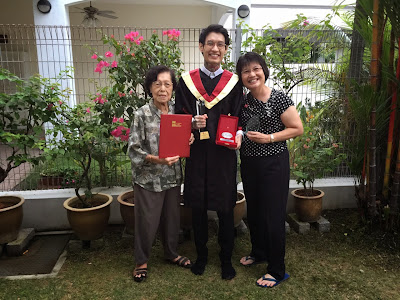�They Changed My Life, so I�ll Change Theirs�
Photo credit: Jade Teo
Just about anyone can volunteer to aid the less fortunate, but would he/she be willing to do so for 18 years?
Ms Sherlyn Khong (pictured above) has been motivated to help since her first trip to the Philippines when she was 22 and, has even founded a non-profit organisation (NGO) called �acts29�.
Since then, the NYP alumnus, who has an IT diploma, has continued to travel to Payatas in Quezon City, Philippines� biggest open dumpsite, with other volunteers, to aid the community living around it.
�Education is our main aim because that�s the most important thing,� said Ms Khong, a part-time tutor, who also doles out scholarships to children through her NGO.
�It�s not about studying for the sake of studying, they study for a purpose.�
Acts29 projects, such as Dream Beyond the Dumpsite, are field trips that let the children of Patayas see beyond their community. Missionaries work directly with a school for the poor to provide free non-formal education for the children living there.
Ms Khong has also taught the children how to use common applications like Microsoft and YouTube. Though she said it in jest, she does wish the Internet speed would be a lot faster.
She told The Write Stuff: �I think there are so many ways to help� So we�re very happy when people and students from Singapore come over to teach.�
Those living in developed countries like Singapore can help even if they can�t travel. For example, they could always make videos or lesson plans. For Ms Khong, she takes a very hands-on and spontaneous approach, if the students are preparing for college, she would set aside time to help them with English essay writing.
St Joseph�s Institution students conducting tutorials in Payatas. Photo credit: acts29
But according to her, there isn�t enough content material or subjects being taught in the schools to prepare them for university, so �the whole village is now struggling� to learn basic subjects, such as trigonometry.
She observed: �It depends on the skill set of the volunteers. If we have a geography teacher, she teaches geography; if we have someone who cooks, then perhaps he/she will work with families to teach them how to prepare nutritious dishes.�
The Payatas community lives around a 12 to 13 storeys� height of trash, which is about 3 years� worth of rubbish collected from metro Manila.
�Just imagine instead of having Ang Mo Kio Central, it�s a mountain of rubbish,� said Ms Khong.
The people who live there are mainly squatters and they live in makeshift houses of about 10-20 square metres. The people build them with anything they find, from cardboard to galvanised sheets or wood, and they are as high as two-storeys.
Scavengers at work on the dumpsite. Photo credit: Sherlyn Khong
�With a lot of the kids we work with, they don�t necessarily differentiate what�s trash and what�s not trash, because everything has value.�
Their parents usually work as scavengers for 12-hour shifts at the dumpsite, so they try to gather about five to eight gunnysacks worth of �goods� before going down to the junk shops to turn in their gatherings and collect their payment.
Unfortunately at the end of the day, �a scavenger could be taking home less than 100 pesos, that would be S$3 or less� and it�s barely enough to survive considering the average family size is about six.
�So it helps them if everyone works, so there�s more money. But that means that the kids drop out of school at 10,� said Ms Khong.
�So our work there is to really work with the scavenging families, support (them) and make sure their 10- and 11-year-olds stay on and go to school, and that can be another challenge. When children work alongside their parents, they see their parents working, and the environment is such that everyone else is working, and they don�t see the point in studying,� she explained.
Ms Khong is a strong believer in the benefits that education can bring, especially for those who can�t afford to go to school.
She believes the children feel that it�s their moral obligation to work and they can�t see far into their future. She remarked that they are often planning for the next day; and don�t see that they would be earning more if the graduate at 24-years-old, enough to buy a proper house for their parents.
And although many think this way, there are some children who know they have a future if they study.
One of Ms Khong�s most touching moments was many years ago, when she met Julian Donaire, who was 17 or 18 at the time.
A scholar from Payatas teaching kids to read. Photo credit: Sherlyn Khong
She said: �He shared with me his story: his parents had abandoned him and he was left with his grandmother. They moved to the dumpsite to stay. At 10-years-old his grandma passed away, so he was all alone.�
Julian had made his own squatter home, a very small room for himself; and he worked at the dumpsite to support himself. He promised himself that he would get an education, so he went to the School for Humanity. This is a non-formal school providing alternative learning for out-of-school kids and teens.
Since 10, he�s been going to that school to learn to read and write. He eventually qualified for Maritime Engineering and he graduated.
Today he�s in his 30s and has a beautiful family, and they�re still living in Payatas.
At the activity centre, scholars and street kids come in to read on Saturdays.
Photo credit: Sherlyn Khong
By Jade Teo, Year 3, Diploma in Mass Media Management
For 18 years, Jade has been tirelessly working on ways to cure �boredom�. She tried watching chefs like Nigella Lawson on TV, creating a solar-powered boat with little success, taking a literature trip to UK with friends, riding in the front seat of an ambulance and a fire truck, but nothing worked as well as her first adventure - writing. Without it and her books, she wouldn�t have been cured.









Comments
Post a Comment